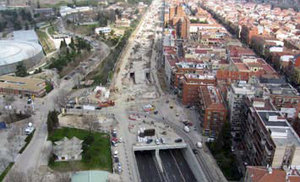

The Madrid M30 motorway, the inner ring road of the city, has been at the centre of a major urban renewal project where the motorway has been redirected underground. In 2004 it was determined that the M30 was a 'barrier' to movement in the urban areas it ran through.
Despite its necessity as part of the road infrastructure of Madrid it caused much pollution to the air and also the Manzanares River which it ran close to.
The Madrid Calle 30 project was undertaken to refurbish the road and reroute major sections of it through tunnels under the city areas with which it is associated.
This now allows the surface areas that used to be asphalt paved to be redeveloped into green park areas, footpaths, cycle paths and new affordable housing.
The new sections of road construction totalled 99km, 56km of which is in tunnels. Construction started in September 2004 and was complete by the second quarter of 2007. The total project budget was estimated at €3.9bn.
M30 Tunnels
The motorway reconstruction took place in sections and was divided into 15 separate projects and four regions – north, south, east and west. A very large number of tunnels had to be built, by using different techniques.
The different tunnels made for the M30 project were:
M30 EAST Tunnels
- Nudo de la Paloma: overall length 5,508m (1,546m of cut and cover tunnel, 175m of conventional tunnel), term of contract 24 months, estimated cost €56m
- Nudo de Costa Rica: overall length 2,078m (892m of cut and cover tunnel, 175m of conventional tunnel), term of contract 15 months, estimated cost €27m
- Nudo de la A-2: overall length 4,460m (510m of cut and cover tunnel, 140m of viaduct), term of contract 16 months, estimated cost €25m
- Nudo de O'Donnell: overall length 6,800m (150m of cut and cover tunnel, 150m of viaduct), term of contract 18 months, estimated cost €18m
- Nudo de la A-3: overall length 4,800m (1,400m of cut and cover tunnel, 430m of conventional tunnel), term of contract 24 months, estimated cost €187m
M30 SOUTH Tunnels
- By-pass Sur: overall length 8,344m (7,212m of conventional tunnel, 632m of cut and cover tunnel), term of contract 30 months, total estimated cost €792m (north tunnel €340 million, south tunnel €429m)
- Conexión Embajadores con M-40: overall length 5,800m (2,460m of cut and cover tunnel), term of contract 18 months, total estimated cost €74m
M30 WEST Tunnels
- Excavation av. de Portugal Hasta Gta. San Vicente: overall length 2,983m (2,674m of cut and cover tunnel), term of contract 36 months, estimated cost €159m
- Excavation M-30 between paseo Marqués de Monistrol and puente de San Isidro: overall length 12,759m (12,719m of cut and cover tunnel, 40m of traditional tunnel), term of contract 36 months, estimated cost €618m
- Excavation between the bridge of San Isidro and the bridge of the Princess: overall length 12,212m (11,852m of cut and cover tunnel, 360m of traditional tunnel), term of contract 26 months, estimated cost €450m
M30 NORTH Tunnels
- By-pass Norte: overall length 10,525m (4,817m of cut and cover tunnel, 4,187m of conventional tunnel), term of contract 30 months, estimated cost €722m (west tunnel €293 million, east tunnel €429m)
- Conexión by-pass Norte con A-I: overall length 5,479m (4,463m of conventional tunnel), term of contract 30 months, estimated cost €474m
TBMs used for the project
In order to build some of the tunnels, the largest TBMs in the world at the time of the project were specially ordered to both a joint venture between Mitsubishi Heavy Industries Ltd (MHI) and Duro Felguera SA, and Herrenknecht AG in Germany.
These two EPB tunnelling machines were used for construction of the south tunnel of the south bypass on the Madrid M30 and the north bypass. These were only one of the seven machines used to carry out the tunnelling excavation for the 15 projects of Madrid Calle 30.
All of the machines used an earth pressure balance shield system, since most of the excavation was in soft ground (little hard rock).
The segment erectors were configured to line tunnels with 70cm-thick segments of concrete although some sections were double lined with a second segmental ring to act as a safeguard against fire – this required a second segment erector on the TBM.
The inner diameter of the tunnels was 13.45m after lining.
(Source: www.roadtraffic-technology.com/projects/m30_madrid)
